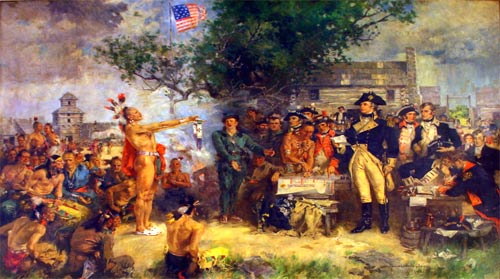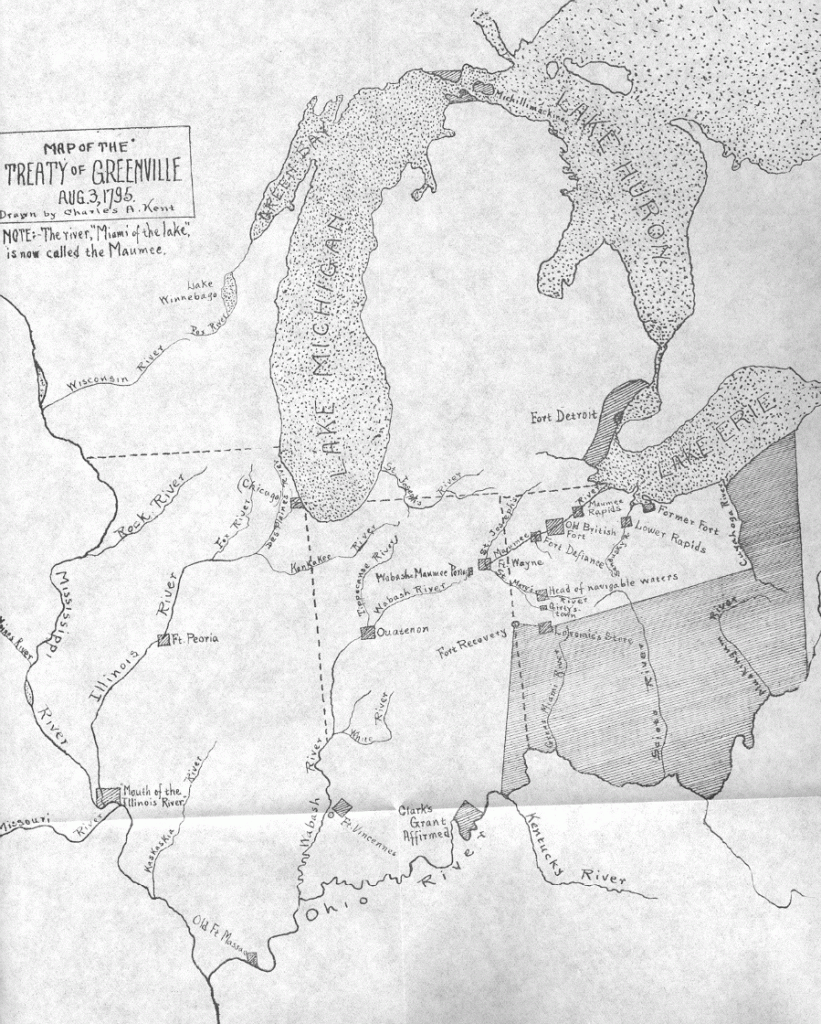1795 Treaty of Greenville

Why was the treaty of Greenville important to western migration into Ohio and Kentucky from Pennsylvania?
After General Anthony Wayne’s decisive defeat of the Ohio Indian tribes at the Battle of Fallen Timbers, leaders of the Indian nations joined with Wayne on August 3, 1795 in signing A Peace Treaty.
This was an important event in the life of the infant nation since the Treaty established a definite boundary between Indian lands and those lands open to white settlement. For the first time in its young history the U.S. was able to govern all its territories.
It was no secret that President Washington was eager to clear the Ohio Valley of Native Americans. By opening up the Northwest Territory to immigration the country would be able to expand its borders, with the resulting increase in trade and commerce.
On three occasions Washington had sent an army to do battle with the Miamis and Shawnees. The first two– led by Josiah Harmer and then by Arthur St. Clair– met the same disastrous fate, almost total decimation of the American forces. The Miami and Shawnee tribes reigned supreme in the Northwest Territory until August of 1794, when Washington dispatched Gen. “Mad Anthony” Wayne with an expedition numbering more than 2500 men. Where his predecessors had failed, Wayne emerged victorious at the Battle of Fallen Timbers near Toledo.
The Treaty was signed by Wayne and representatives from a dozen Indian nations and tribes at Greeneville (sic), northwest of the Ohio River on August 3, 1795. Specifically: “A Treaty of Peace Between the United States of America and the Tribes of Indians called Wyandots, Delawares, Shawanoes, Ottawas, Chipewas, Putawatimes, Miamis, Eel-River, Weeas, Kickapoos, Piankashaws and Kaskaskias.”
The Treaty of Greenville was signed at Fort Greenville (now Greenville, Ohio), on August 3, 1795, between a coalition of American Indian tribes, known as the Western Confederacy, and frontiermen of the United States; it followed the Native American loss at the Battle of Fallen Timbers the previous year. The treaty ended the Northwest Indian War in Ohio Country.
The United States was represented by General “Mad Anthony” Wayne, who led the victory at Fallen Timbers. In exchange for goods to the value of $20,000 (such as blankets, utensils, and domestic animals), the American Indian tribes ceded to the United States large parts of modern-day Ohio, the future site of downtown Chicago,[nb 1][2] the Fort Detroit area, Maumee, Ohio Area,[3] and the Lower Sandusky Ohio Area.[4]
American Indian leaders who signed the treaty included leaders of these bands and tribes:
- Wyandot
- Delaware (Lenape; several bands)
- Shawnee
- Ottawa (several bands)
- Chippewa
- Potawatomi (several bands)
- Miami (several bands)
- Wea
- Kickapoo
- Kaskaskia
The treaty established what became known as the “Greenville Treaty Line,” which was for several years a boundary between American Indian territory and lands open to European-American settlers. The latter frequently disregarded the treaty line as they continued to encroach on native lands guaranteed by the treaty. The treaty line began at the mouth of the Cuyahoga River in present-day Cleveland and ran south along the river to the portage between the Cuyahoga and Tuscarawas River, in what is now known as the Portage Lakes area between Akron and Canton. The line continued down the Tuscarawas to Fort Laurens near present-day Bolivar. From there, the line ran west-southwest to near present-day Fort Loramie on a branch of the Great Miami River. From there, the line ran west-northwest to Fort Recovery, on the Wabash River near the present-day boundary between Ohio and Indiana. From Fort Recovery, the line ran south-southwest to the Ohio River at a point opposite the mouth of the Kentucky River in present-day Carrollton, Kentucky.
William Clark of the Lewis and Clark Expedition was present at Greenville. Years later he met again one of the Delaware chiefs from the conference, and noted in his journal for December 23, 1803: “a raney [sic] day… several Deleaway pass, a chief whome I saw at Greenville Treaty, I gave him a bottle of whiskey.”[7]
Nearly twenty years later, on July 22, 1814 General William Henry Harrison and Governor Lewis Cass held a second treaty signing at Greenville, with the Wyandot, Delaware, Shawnee, Seneca, Miami and Potawatomi tribes.[9] That treaty brought support from those tribes for the US during the War of 1812.
Take from http://www.touring-ohio.com/history/greeneville-treaty.html
The parties returned to Greene Ville and on August 3, 1795 signed the treaty. In so doing they agreed to cede claims to lands east of the Cuyahoga River to Fort Laurens in Tuscarawas County, and south of a line running west to Fort Recovery. In return, the United States offered payment and annuities in the form of goods and ceded claim to most land north and west of the treaty line.
 This treaty marked the end of the Indian Wars in the Ohio Country, forsaking boundary violations by both parties, and established the official western border of the United States, opening much of Ohio for settlement. The treaty was not perfect by any means and the peace between the Americans and native peoples of Ohio would not last.
This treaty marked the end of the Indian Wars in the Ohio Country, forsaking boundary violations by both parties, and established the official western border of the United States, opening much of Ohio for settlement. The treaty was not perfect by any means and the peace between the Americans and native peoples of Ohio would not last.
Confined to only about 1/4 of the land that had supported them for 100s of years, the Shawnee, Delaware and Wyandot peoples suffered. Traders who had long been known to supply alcohol to the indians to gain advantages over them, again began fueling the fires of the native peoples depression. Some of the warriors became drunkards. But others, particularly the Shawnee were living near present day Wapakoneta, turned their backs on the old ways, and tried to become a part of the encroaching American civilization.
Over the next 10 years from the signing of the treaty, the government continued to acquire more Indian land through purchases and new treaties. A shift in American policy also began after the signing. With the destruction of so many Indian villages and crops, they became increasingly dependent upon others for their survival. It was feared that with Ohio’s close proximity to the British north of the Great Lakes, the Indians might turn to them for sustenance that would eventually lead to further inroads by the British into the northern Ohio territory.
One Native American rose to power during this time. His name was Tecumseh. He scolded the signers of the treaty for giving away lands they had no right to give away. As time passed the number of like-minded Native American’s increased, Tecumseh began traveling across the country trying to enlist more Nations to band together to resist the Americans. The Shawnee leader eventually amassed a force of about 2000 warriors from various tribes found in the Northwest Territory.
Native Americans were never of one mind or purpose and Tecumseh found it difficult to unite them in one cause. Frustrated, he turned to the British/Canadians for help. Although they did supply him with essential materials and supplies, it wasn’t until the Americans declared war on the British in 1812 that the actively supported those under the leadership of Tecumseh. Tecumseh was killed in one of the last battles of the war, thus ending Tecumseh’s dream of a united Native American Nation.
The parties returned to Greene Ville and on August 3, 1795 signed the treaty. In so doing they agreed to cede claims to lands east of the Cuyahoga River to Fort Laurens in Tuscarawas County, and south of a line running west to Fort Recovery. In return, the United States offered payment and annuities in the form of goods and ceded claim to most land north and west of the treaty line.
This treaty marked the end of the Indian Wars in the Ohio Country, forsaking boundary violations by both parties, and established the official western border of the United States, opening much of Ohio for settlement. The treaty was not perfect by any means and the peace between the Americans and native peoples of Ohio would not last.
Confined to only about 1/4 of the land that had supported them for 100s of years, the Shawnee, Delaware and Wyandot peoples suffered. Traders who had long been known to supply alcohol to the indians to gain advantages over them, again began fueling the fires of the native peoples depression. Some of the warriors became drunkards. But others, particularly the Shawnee were living near present day Wapakoneta, turned their backs on the old ways, and tried to become a part of the encroaching American civilization.
Over the next 10 years from the signing of the treaty, the government continued to acquire more Indian land through purchases and new treaties. A shift in American policy also began after the signing. With the destruction of so many Indian villages and crops, they became increasingly dependent upon others for their survival. It was feared that with Ohio’s close proximity to the British north of the Great Lakes, the Indians might turn to them for sustenance that would eventually lead to further inroads by the British into the northern Ohio territory.
One Native American rose to power during this time. His name was Tecumseh. He scolded the signers of the treaty for giving away lands they had no right to give away. As time passed the number of like-minded Native American’s increased, Tecumseh began traveling across the country trying to enlist more Nations to band together to resist the Americans. The Shawnee leader eventually amassed a force of about 2000 warriors from various tribes found in the Northwest Territory.
Native Americans were never of one mind or purpose and Tecumseh found it difficult to unite them in one cause. Frustrated, he turned to the British/Canadians for help. Although they did supply him with essential materials and supplies, it wasn’t until the Americans declared war on the British in 1812 that the actively supported those under the leadership of Tecumseh. Tecumseh was killed in one of the last battles of the war, thus ending Tecumseh’s dream of a united Native American Nation.
